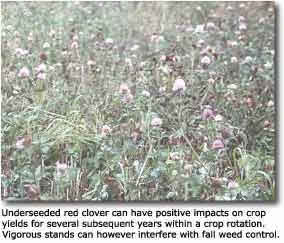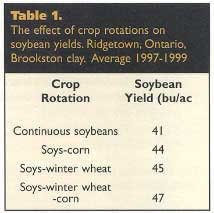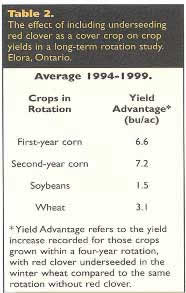
Wrestling
with Crop Rotation Decisions
In a season where no crop seems to
stand out as a profit producer, it is difficult to get excited about pondering
crop selections or sequences for this fall or next year. However, a year like
2000 reinforces the need for sticking with crop rotations that build soil
structure, improve water infiltration and lend themselves to reduced tillage
systems in order to provide some protection  against
soil erosion.
against
soil erosion.
Unfortunately, the most profitable crop rotations in the short term are being
increasingly positioned as less sustainable and even less profitable when
a slightly longer time frame is considered. Several studies have positioned
the corn-soy-soy rotation as being the most profitable rotation in the U.S.
Cornbelt. Unfortunately this rotation has some obvious weaknesses:
Multiple Year Soybeans
The dominant use of soybeans in long-term rotation studies has produced some
compelling numbers. One of these studies was conducted at the Woodslee Research
Station (soil type: Brookston clay loam) by Agriculture and Agri-Food Canada
researchers Susan Weaver, Al Hamill and Jianhua Zhang. They compared crop
rotations of continuous soybeans, corn-soys, and corn-soys-wheat (among others).
Soybean yields declined quite dramatically over the course of the nine-year
experiment in the continuous soybean plots.  This
trend was less noticeable in the corn-soy rotation, and soybean yields were
most consistent in the three-year rotation including wheat. At the conclusion
of the experiment all plots, regardless of the previous rotations, were planted
to corn. When examined as groups, all rotations which included winter wheat
resulted in significantly higher corn yields than those rotations that included
only corn or soybeans.
This
trend was less noticeable in the corn-soy rotation, and soybean yields were
most consistent in the three-year rotation including wheat. At the conclusion
of the experiment all plots, regardless of the previous rotations, were planted
to corn. When examined as groups, all rotations which included winter wheat
resulted in significantly higher corn yields than those rotations that included
only corn or soybeans.
More recently, Doug Young, agronomist with Ridgetown College, University of
Guelph, has compiled some interesting crop rotation results. These rotation
studies were initiated in 1994 and include four distinct crop rotations. The
rotations and average soybean yields obtained over the last three years are
illustrated in Table 1. Continuous soybeans lag significantly behind the other
non-monoculture options, with highest yields resulting from the three-year
rotations.
The message is fairly clear. The idea of swamping your crop rotation with
soybeans to the point of continuous soybeans spells trouble. What is more
difficult to get a good handle on is the impact of the popular crop rotation
that has two years of soybeans back-to-back in a four-year rotation. Work
done in Wisconsin showed that second-year soybeans often yielded quite well
relative to first-year soybeans and certainly better than beans in the third
consecutive year. Probably the biggest threats to two years of soybeans are
reduced soil structure and increased soybean cyst nematodes. Results would
indicate that low populations of soybean cysts can multiply rapidly in that
second year of soybeans and cause real problems with soybean yield potential.
Meanwhile, Tony Vyn's previous work from the University of Guelph indicated
that two years of soybeans in a four-year rotation often resulted in poorer
soil structure and greater erosion potentials than other less soybean-intensive
rotations.
Repeating the Red Clover
Song
 Ken
Janovicek, crop scientist at the University of Guelph (Department of Plant
Agriculture), has taken a closer look recently at the value of red clover
in a rotation. He compared crop yields over the past six years between two
crop rotations. These rotations were the same, corn-corn-soy-winter wheat,
with one exception: the wheat was underseeded to red clover in one set of
plots and not in the other. These rotations had been in place since the early
1980's. Table 2 illustrates the yield advantages for the rotation including
red clover for each crop in the four-year sequence. Janovicek calculates that
at average prices there is a $63/ac increase in revenue over the four years.
Add to this a reduced nitrogen cost of $12/ac in year one, (first-year corn)
and you have an $85 benefit to the clover at an establishment cost of approximately
$15.
Ken
Janovicek, crop scientist at the University of Guelph (Department of Plant
Agriculture), has taken a closer look recently at the value of red clover
in a rotation. He compared crop yields over the past six years between two
crop rotations. These rotations were the same, corn-corn-soy-winter wheat,
with one exception: the wheat was underseeded to red clover in one set of
plots and not in the other. These rotations had been in place since the early
1980's. Table 2 illustrates the yield advantages for the rotation including
red clover for each crop in the four-year sequence. Janovicek calculates that
at average prices there is a $63/ac increase in revenue over the four years.
Add to this a reduced nitrogen cost of $12/ac in year one, (first-year corn)
and you have an $85 benefit to the clover at an establishment cost of approximately
$15.
The trouble with keeping red clover in the province’s rotations has been
one of uniform stand establishment (and maintaining the stand) in the winter
wheat crop. As well, vigorous stands of red clover have often been blamed
with poor control of perennial weed problems or of requiring additional fall
tillage. The merits of red clover warrant researchers and producers coming
up with solutions to these problems. Peter Johnson, cereal specialist with
the Ontario Ministry of Agriculture, Food and Rural Affairs, declares that
using single-cut red clover will give nearly all of the benefits of double-cut
red clover, but it will be much easier to control in the fall and will interfere
less with quackgrass and bindweed spraying.
Reality Check
Short-term considerations (i.e., survival) often outweigh the longer-term
agronomic considerations. Growers feeling pressure to plant more restrictive
rotations (such as back-to-back corn or back-to-back soybeans) should do so
realizing their options, benefits and risks. Taking the appropriate soil samples
this fall to determine your soybean cyst nematode risk can provide you with
valuable information about the potential downside of additional soybeans in
your rotations. Fusarium infection in winter wheat fields seems to be increasing
risk and management demands. However, making the effort to include winter
wheat and underseeded red clover somewhere in your rotations can build soil
structure and increase the profit potential for other crops in the rotation
even when weather or commodity prices force you into less than ideal rotation
decisions.